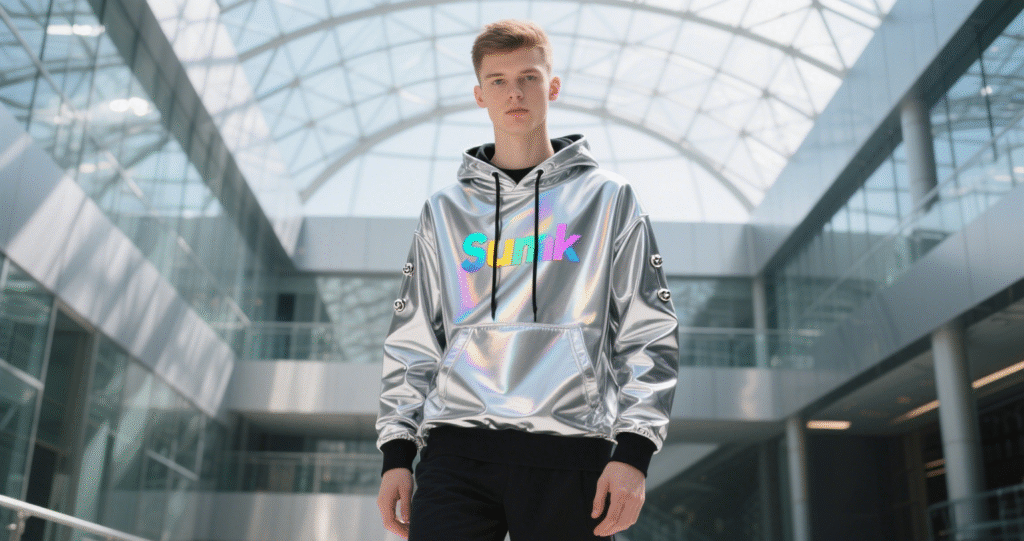Hoodies were invented in the 1930s by the sportswear brand Champion to keep warehouse workers warm. Over the decades, hoodies evolved from functional workwear to a global fashion staple across sports, music, and street culture.
We all know and love today has a fascinating history that dates back nearly a century. Soft cotton, cozy hood, perfect kangaroo pocket. We love it.
Who First Invented and Created the Hoodie?
In the early 1930s, the Champion Knitwear Company in Rochester, New York, stitched together what we now recognize as the first true hoodie. Designed for laborers loading and unloading refrigerated trucks, Champion added an oversized hood to its signature sweatshirt, providing essential head and neck warmth in frigid conditions.
The history of the hoodie
- 1930s – Practical Workwear
Invented for factory and warehouse workers who needed warmth and comfort on the job. - 1970s – Symbol of Street Culture
Adopted by hip-hop artists, skateboarders, and graffiti artists, hoodies became symbols of rebellion and urban culture. - 1990s – Mainstream Fashion
Major brands like Nike and Adidas elevated the hoodie into mainstream fashion, often featured in runway collections and pop culture. - 2000s to Today – Global Style Essential
Now, hoodies are everywhere—from luxury brands to athletic wear. They balance comfort, style, and cultural relevance.
By the 1970s, collegiate athletes and gym enthusiasts adopted Champion’s hooded sweatshirt as part of their training gear. Universities printed their mascots and colors on the garment, turning it into an unofficial symbol of campus pride.
In the 1980s and ’90s, hoodies transcended athletics. Hip-hop artists, skateboarders, and breakdancers embraced the hoodie’s comfort and edge.
Today, nearly every major sportswear and luxury brand—from Nike and Adidas to Supreme, Gucci, and Balenciaga—offers its own hoodie. What began as cold-weather PPE now serves as a canvas for branding, artistic prints, and high-end fabrics.

The design of the hoodie
Early hoodies were made from cotton jersey. Sinking looms produced a heavier, denser fabric. Protecting athletes from winter’s cold weather. Today, hoodies are made from lighter, thinner terry knit fabrics. This helps improve the feel while keeping costs down.
The shape of the hoodie has also changed over the years. In the early 1930s, hoodies were deliberately designed with dropped shoulders so that athletes could wear them over shoulder pads. Today, most hoodies and sweatshirts have moved away from utilitarianism. They have a straight-cut design so that they fit perfectly when layered with jackets and coats.
The core feature of the hoodie is the hood with knotted drawstring and metal grommets. This design fits perfectly on any wearer’s head and blocks cold winds from any direction. No need to carry a jacket or umbrella, everything is on your back.
A classic hoodie features:
- Pull-over style or zip-up front
- Adjustable drawstring hood for fit and weather protection
- Kangaroo pocket for warmth and storage
- Ribbed cuffs and hem to seal in heat
- Modern variations experiment with fabrics (fleece, French terry), cuts (oversized, cropped), and details (graphic prints, technical zippers).
Details like fastenings, trims and pockets can add a touch of colour to a practical hoodie. Some styles feature a central zip. There are kangaroo-shaped pockets or side pockets on the front to keep your hands warm. Fine ribbing at the cuffs and hem ensures the garment stays close to the body and does not move around at the hips and wrists when you move.

Why was the hoodie invented?
The hoodie’s invention was driven by practicality. Workers in cold environments need a work garment that is easy to wear and protects. Its combination of warmth, ease of movement, and head protection makes it a natural choice.
The hoodie’s simple structure makes it easy to mass produce and customize, so it has quickly been used outside the industrial field. Over time, the hoodie took on new meanings—from work garment to a symbol of individuality and self-expression.
Why the Hoodie Endures
So why does the hoodie continue to be so popular after nearly 100 years? It’s simple:
- Comfort: Soft fabrics and relaxed fits make hoodies perfect for almost any occasion.
- Functionality: The hood and pockets provide warmth and practicality.
- Style: Hoodies can be minimalist or bold, classic or trendy — fitting any personality.
- Versatility: From lounging at home to hitting the gym or the streets, hoodies fit right in.
Cultural Significance Today of Hoodies
What began as workwear evolved into a symbol of individuality and rebellion. Hoodies have been worn by college students, athletes, hip-hop artists, and even social activists. Today, they represent comfort, versatility, and personal expression.
- Youth identity: For many young people, a hoodie signals casual confidence and individuality.
- Social statements: Hoodies have appeared in powerful protest imagery, symbolizing solidarity and resistance.
- Gender-neutral appeal: Universally flattering cuts and relaxed fits mean hoodies cross gender lines effortlessly.
- Luxury reinterpretations: Designers experiment with cashmere, silk blends, and avant-garde silhouettes to redefine what a hoodie can be.
The hoodie symbolizes both rebellion and inclusion. It has been a uniform for activists (known as “hoodie solidarity” in social justice movements) and a canvas for artists. Celebrities and designers continue to reinterpret it, ensuring that the hoodie remains a powerful cultural icon.
The hoodie has become a symbol of solidarity and activism. During protests and movements, hoodies are used to show support for causes and unite individuals who share a common goal. The “hoodie movement” gained momentum after the tragic shooting of Trayvon Martin in 2012, highlighting the hoodie as a symbol of racial discrimination and social injustice.
Few garments have as much symbolism and cultural significance as the hoodie, a social trend and leisure staple that has slowly gained acceptance and undergone transformation after transformation.

Modern Hoodie Trends
Today’s hoodies come in various styles, from luxury fashion collaborations to eco-friendly, sustainable designs. Whether you prefer oversized, cropped, or performance hoodies, they remain a staple in wardrobes worldwide.
- Sustainable materials: Organic cotton, recycled polyester.
- Tech-enabled: Built-in wireless headphone channels or heated panels.
- Luxury collaborations: High-end labels releasing limited-edition hoodies.
- Gender-neutral fits: Designed to flatter any body type.
Technological Innovations in Hoodie
Advancements in Fabric and Material
Modern hoodies are made from advanced fabrics. They offer improved comfort, durability, and functionality. Brands are experimenting with materials including moisture-wicking fabrics, thermal fabrics, and even eco-friendly fabrics. These innovations allow hoodies to adapt to a variety of activities and weather conditions.
Customization and Personalization Trends
3D printing has introduced new possibilities for personalized hoodie designs. Custom hoodie manufacturers can print any complex pattern, logo, or pattern onto the garment. This trend has led to a surge in personalized hoodies, from unique prints to custom embroidery.
If you also want to create a hoodie with your own unique design, you can always contact them.
What is the perfect hoodie?
Everyone has a different idea of the perfect hoodie.
The perfect hoodie is:
- Comfortable for daily wear
- Durable for years of use
- Stylish without trying too hard
- Functional (pockets, hood, warmth)
- Versatile (can wear lounging, out with friends, or layered for smarter looks)
If you want to customize the perfect hoodie. And create a brand to start your business.
Here are some tips:

The Future of the Hoodie
With advancements in technology and fashion trends, the future of the hoodie looks bright. Sustainable practices and innovative designs are likely to play a major role in shaping its future. The hoodie will continue to remain influential in the apparel space and adapt to the changing needs and preferences of consumers.
Sustainability and Eco-Friendly Materials
With the increasing awareness of environmental protection, sustainable hoodie production practices and eco-friendly materials are the direction of development for many brands. Organic cotton, recycled polyester and low-impact dyes are becoming more and more common in hoodie designs. All this shows that people are becoming more and more aware of the environmental impact of clothing.
Technological Integration
The integration of technology into hoodie design is an exciting development. Innovations such as heated fabrics, built-in LED lights, and smart textiles are making their way into hoodie designs. These technological advancements offer enhanced functionality and convenience, pushing the boundaries of what a hoodie can be.
Frequently Asked Questions (FAQ)
Did hoodies exist in the 1800s?
No, hoodies didn’t exist in the 1800s.
Did they have hoodies in the 1960s?
Yes. Hoodies gained popularity in the 1960s, especially in U.S. college campuses and athletic wear. The style started transitioning from workwear to mainstream fashion during this era.
Did hoodies exist in the 70s?
Yes. In the 1970s, hoodies became part of street fashion, strongly influenced by hip-hop culture in New York. Films like Rocky also helped popularize the hoodie look.
Why do Americans wear hoodies?
Hoodies are popular in the United States for their comfort, versatility and cultural appeal. They are perfect for casual wear, sportswear, and are also a symbol of personal style and community identity.
Why do rappers wear hoodies?
Rappers wear hoodies as a symbol of urban culture, individuality, and resistance. The hoodie represents authenticity and has deep roots in hip-hop and street style.
Who invented the zip-up hoodie?
Champion invented the zipper in the 1930s, making it more practical and quickly becoming a must-have item for sports and casual wear.




